Scottish Marine and Freshwater Science Volume 3 Number 3: Clyde Ecosystem Review
A review of previously published information and knowledge concerning the Firth of Clyde ecosystem and suggestions for further studies in the Clyde required in order to support sustainable use of this active Scottish marine ecosystem
9. CLYDE MANAGEMENT EVALUATION MODEL ( CMEM)
Recently there has been a call to re-instate spatial management measures in the Clyde, including the 3 nautical mile limit which had been in place in this region from 1962-1984. The limit is thought to have provided important refuges for many commercial whitefish species and may allow for fish stock recovery in the Clyde (Thurstan and Roberts, 2010). Since the removal of the 3 mile ban the fisheries in the Clyde have changed considerably to a Nephrops dominated fishery, and policy changes now need to consider wider ecosystem impacts in addition to the ecological status of fish and shellfish stocks and the economic status of the fishery.
Effective fisheries management is nearly always hindered by uncertainties which can be particularly problematic for rebuilding fisheries when trying to balance the need to reduce fishing effort and to ensure rebuilding, with the need to meet social and economic needs of fishery stakeholders, both in the short term and the long term (Holland, 2010). Scientific support is required at key steps of fisheries management; for monitoring, assessment and decision making. Scientific tools that evaluate the potential outcome of management strategies are therefore required to support their practical implementation.
Spatial and temporal closures are common practice in the Clyde ( e.g. Ballantrae Bank and the cod seasonal closure) and, with the possibility of re-instating a 3 mile limit, tools that look at the spatial and temporal dynamics of the Clyde fisheries are particularly valuable. In addition, it is useful to create a tool that looks at wider ecological impacts by assessing potential effects on habitats. The aim of this section of the report is to describe the development of a spatial management evaluation tool that aims to have practical application for assessing fisheries management options and policy initiatives for the Clyde Sea area. The tool will incorporate data on the topography and sedimentology of the sea bed in addition to analysing fishing activity patterns using Vessel Monitoring Systems ( VMS) data. This management evaluation model developed for the Clyde is intended to be used to inform an exploratory and adaptive decision-making process. In this section we address a small range of questions. However, it is available to the community to provide quantitative evidence for any suggested spatial measure.
9.2 Methodology and Model Data Layers
Development of the evaluation model was built using the statistical programming software R, version 2.13.1.
The first step in developing the model was to implement a basic model grid that provides information at a relevant spatial resolution. This was chosen as 0.25' latitude x 0.5' longitude (approximately 500m x 500m) per grid cell in order to be able to spatially resolve known management measures. The outside limits of the model grid were longitudes 5° 50' W to 4° 30.5' W and latitudes 54° 50'N to 56° 20.25'N. This gave a model grid of 161 grid cells and 361 grid cells in the east and north directions respectively. An illustration of the grid created can be seen in Figure 9.1.
Figure 9.1 Evaluation model grid - 0.25' latitude x 0.5' longitude (approximately 500m x 500m) over the Clyde Sea area.
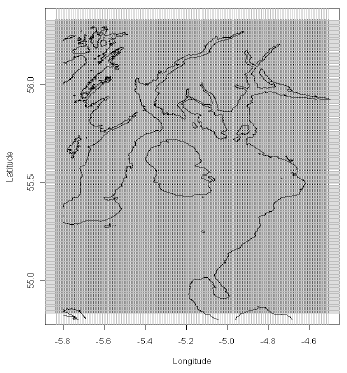
The longitude ( x i) of the left hand, bottom of a grid cell i,j is calculated as,

And the latitude ( y j) of the left hand, bottom of grid cell i.j is calculated as,

The distances involved in this model grid are as follows,
- Width of 0.5º longitude grid cell at southern limit (54° 50'N) = 533.7m
- Width of 0.5º longitude grid cell at northern limit (56° 20'N) = 513.7m
- Height of 0.25º latitude grid cell = 463.3m
A central-point grid cell area of 523.7m x 463.3m = 2.43 x 10 5 m 2 (0.243 km 2) is used for all area calculations
The resulting 161 x 361 grid covered both land and sea so that a mask was needed to determine which grid points were on land and which grid points were marine. This was achieved using the GEBCO coastline data ( GEBCO, 2011). The resulting mask ( M all i,j ) had a grid-cell value of 1 for water grid cells, and 0 for land grid cells.
Additional masks representing one, two and three nautical mile limits (domains) from the coast were created using the buffer tool in ArcGIS which were then exported for use in R,
M one i,j = 1 for cells in between the coast and 1 nm seawards, otherwise 0
M two i,j = 1 for cells in between the coast and 2 nm seawards, otherwise 0
M three i,j = 1 for cells between the coast and 3 nm seawards , otherwise 0
Using the series of masks, the evaluation model can be used to investigate the potential implications, impacts and benefits of enforcing different spatial limits.
Bathymetric data for the Clyde was obtained from BGS/SeaZone (2011a). The data set was then interpolated by linear interpolation onto the model grid so that each 161 x 361 grid cell had an associated depth value ( d i,j), where d i,j was a real value for marine grid cells and zero for land grid cells. The method used a bivariate linear interpolation in the triangles bounded by the data points which is based on algorithms developed by Akima (1978).
Areas within the model can be calculated by summing grid cells within the chosen domain and multiplying by the area of a single cell ( A cel l),

Where domain can be one, two, three or all and A cell = 0.243 km 2
Volumes can be similarly calculated by summing the product of the depth of each individual cell and the cell area,

Where again domain can be one, two, three or all.
Sediment type is indicative of where certain habitats occur and where particular fishing grounds are located, for example Nephrops are found on mud, sand and sandy mud sediments but not found on gravel sediments. This data is particularly useful for the evaluation model to determine potential habitats affected by spatial closures. Sediment type data was obtained from BGS/Seazone (2011b). Sediment type associated with each 161 x 361 model grid cell ( SedType i,j) was then determined in Arc GIS and coded based on the folk triangle classification of gravel percentage and sand to mud ratio ( Figure 9.2) the data was then exported for use in R. Land grid cells held a null value, as did cells where no sediment data was available such as within smaller sea lochs and very close to the shore.
Figure 9.2 Folk triangle classifications of sediment gravel percentage and sand to mud ratio.
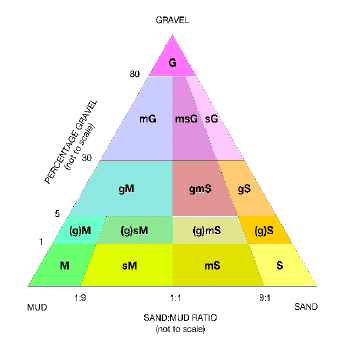
9.2.6 Fishing Activity Data ( VMS)
For control and enforcement purposes, all fishing vessels above 15m in length are equipped with satellite-based Vessel Monitoring by Satellite systems ( VMS) recording their position at regular time intervals. This VMS data is a valuable source of information and can be used to study spatial and temporal patterns of fishing activity (Mills et al., 2007) which can in turn inform fisheries and environmental management. However, due to their low resolution, at 2 hour intervals, these data may provide a biased perception of fishing activity (Hintzen et al., 2010). Applying an interpolation technique between VMS data points provides higher resolution gear-specific data on fishing activity in the Clyde.
Data Extraction
VMS and landings data in 2010 for the Clyde Sea area were extracted from the Scottish Government Fisheries Information Network ( FIN) database. This data was then linked by vessel PLN number within R routines. Raw VMS data included latitude, longitude, date, time, vessel identification, vessel speed and other data quality and checking parameters. The duration since the last ping in seconds ( Tping kboat) was calculated and added as an additional parameter to each raw ping data record. If Tping kboat exceeded 4 hours, the data was rejected.
The integer kboat identified each vessel which had recorded VMS pings within the Clyde. For 2010 this was a total of 90 vessels (66 targeting Nephrops and 24 scallops)
Fishing Time
The speed range used to determine if a vessel is fishing was established as 1-4 knots based on a frequency analysis of the Clyde VMS data ( Figure 9.3).
Figure 9.3 Histogram of fishing vessel speeds from VMS data in the Clyde 2010. From this analysis fishing is determined as VMS pings where speed is between 1 and 4 knots, inclusively.
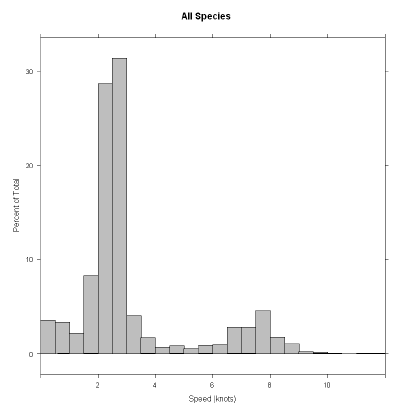
Data Interpolation
In the raw data, Tping kboat varies between a few minutes and 4 hours, although the majority were approximately 2 hours. In the worst case scenario, a vessel travelling at 4 knots will move 29km in 4 hours. Obviously this is much greater than the model grid spacing. Therefore some interpolation is required. At 4 knots it takes a vessel 4 minutes to traverse 500m. Therefore, in order to obtain at least one interpolated VMS position within each grid cell a vessel passes through, each raw VMS track needs to be interpolated with a time resolution of <4 minutes.
The method used for interpolating vessel trajectories from the extracted VMS data points to obtain higher-resolution data was the cubic Hermite spline (cHs) interpolation method described by Hintzen et al. (2010). The cHs method uses position, heading and speed to interpolate the track of a vessel between two succeeding data points and was shown by Hintzen et al. (2010) to approximate the real vessel track markedly better than a straight line interpolation. The 'vmstools' package created in R allows the use of the cHs interpolation function based on the fishing speed associated with the particular fisheries in the Clyde. Interpolated pings that fell on land grid-cells ( e.g. when traversing around a headland) were removed (this was less than 0.2% of the interpolated data).
Final VMS Data Sets - Fishing Time
The final data sets were 161 x 361 values of total grid cell fishing time ( Tfish i,j), calculated as the sum of all values of Tping kboat which fell within the grid cell i,j. Tfish i,j can be calculated for vessel trips which land any fish or shellfish, or for individual species landed, such as Nephrops, Scallops, cod or haddock. Tfish i,j can also be calculated either for raw VMS data, or for interpolated data. Both are used in the results section.
Final VMS Data Sets - Landings
It should be noted that landings could be allocated to model grid cells if an assumption is made that the landings of a vessel is distributed across its fishing pings linearly proportional to fishing time. This has not yet been done with this data set.
The interpolated bathymetry is shown in Figure 9.4. For this section a standard map projection is used throughout.
Figure 9.4 Bathymetry data values interpolated onto the 161 x 361 management evaluation grid using linear interpolation.
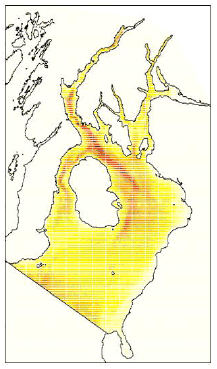
The distribution of depth, by area is shown in Figure 9.5, and tabulated below.
| Depth | Area | Percentage Area |
|---|---|---|
| 0 | 3671.0 | 100.0 |
| 10 | 3323.1 | 90.5 |
| 20 | 3046.5 | 83.0 |
| 30 | 2742.9 | 74.7 |
| 40 | 2277.3 | 62.0 |
| 50 | 1633.9 | 44.5 |
| 60 | 1026.1 | 28.0 |
| 70 | 707.5 | 19.3 |
| 80 | 438.7 | 11.9 |
| 90 | 305.2 | 8.3 |
| 100 | 209.9 | 5.7 |
| 110 | 132.0 | 3.6 |
| 120 | 92.2 | 2.5 |
| 130 | 68.7 | 1.9 |
| 140 | 45.6 | 1.2 |
| 150 | 29.4 | 0.8 |
| 160 | 8.7 | 0.2 |
| 170 | 0.0 | 0.0 |
Figure 9.5 Distribution of depth by area in the Clyde.
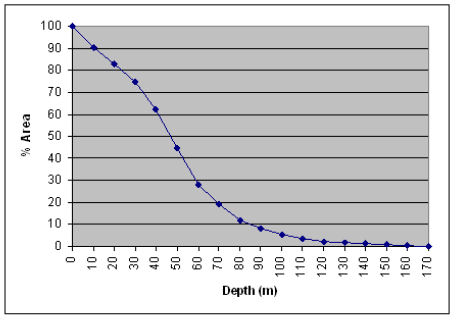
Potential Maerl Habitats
One use such data can be put to is to determine what habitats potentially maerl might inhabit in the Clyde. Hall-Spencer (1995) suggested that maerl is located between 6-18m in the Clyde. Using the depth distribution shown above, it can be estimated that there is 360 km 2 of sea bed in the Clyde in this depth range, i.e. approximately 10% of the Clyde Sea area. The majority of this lies within the 1nm zone (see below).
The spatial masks derived for the domains 1nm, 2nm and 3nm from the coastline are shown in Figure 9.6.
Figure 9.6 Spatial masks derived for the domains 1nm, 2nm and 3nm from the coastline. All coloured grid cells have a value of 1, all others 0.
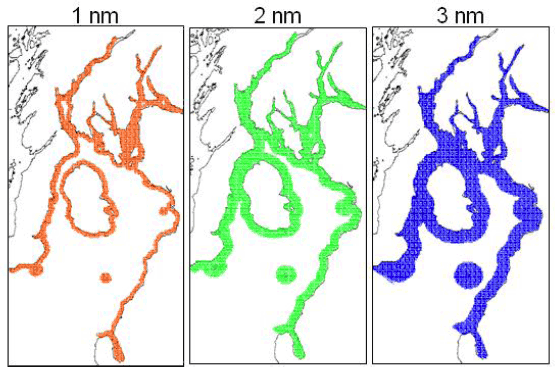
9.3.4 Areas and Volumes of the Clyde Spatial Domains
The spatial limit masks, combined with the data grid of bathymetry, provide the following details concerning the Clyde Management Area,
| Spatial Domain | Surface Area (km 2) |
Surface Area (%) |
Volume (km 3) |
Mean Depth (m) |
Max. Depth (m) |
Min. Depth (m) |
No. of Valid Grid Points |
|---|---|---|---|---|---|---|---|
| Clyde Sea | 3671 | 100% | 179 | 48.66 | 170 | 3 | 15,129 |
| Coast to 1 nm | 1206 | 33% | 36 | 30.22 | 165 | 3 | 4,971 |
| Coast to 2 nm | 1858 | 51% | 72 | 38.97 | 170 | 3 | 7,659 |
| Coast to 3 nm | 2354 | 64% | 102 | 43.40 | 170 | 3 | 9,702 |
Hence from these figures we can see that, of the 3671 km 2 of the Clyde Sea, 33%, 51% and 64% lies within 1 nm, 2nm and 3nm from the coast respectively, by area.
The gridded sediment type distribution for the Clyde Sea is shown in Figure 9.7.
Figure 9.7 Plot showing the gridded sediment type of the Clyde Sea area. The detailed sediment types of Figure 9.2 have been regrouped into the simpler set of gravels, sands and muds.
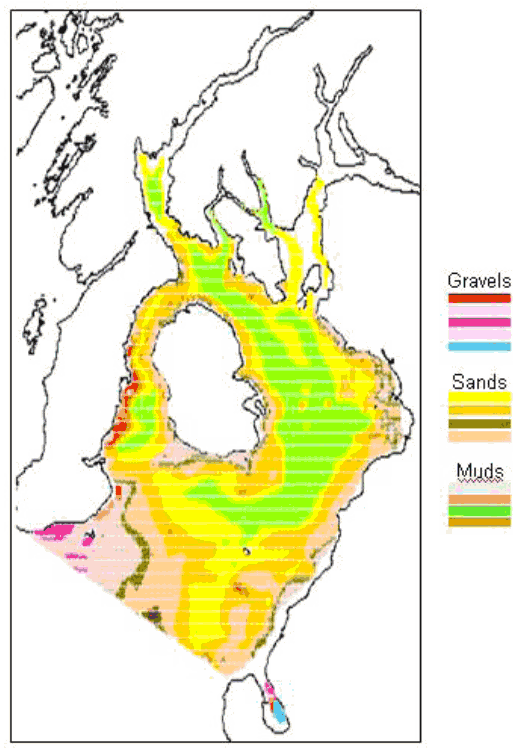
The sediment type codes, combined with the various domain masks, provided the following information about percentage area cover of each sediment type,
| Sediment Type | All Clyde Sea (%) | Coast to 1 nm (%) | Coast to 2 nm (%) | Coast to 3 nm (%) | |
|---|---|---|---|---|---|
| GMSD | Gravelly Muddy Sand | 1.1 | 4.7 | 2.7 | 1.9 |
| GRSS | Gravel, Sand and Silt | 3.3 | 8.7 | 7.3 | 5.7 |
| GV | Gravel | 0.8 | 2.6 | 1.7 | 1.4 |
| GVSD | Gravelly Sand | 3.5 | 1.8 | 3.2 | 3.3 |
| GVMD | Gravelly Mud | 0.2 | 1.2 | 0.6 | 0.4 |
| MDGV | Muddy Gravel | 0.1 | 0.2 | 0.2 | 0.1 |
| MSGR | Muddy Sandy Gravel | 0.4 | 1.8 | 0.9 | 0.7 |
| MUD | Mud | 24.0 | 7.6 | 12.8 | 18.2 |
| MUSD | Muddy Sand | 0.8 | 0.9 | 1.2 | 1.0 |
| SDGV | Sandy Gravel | 2.9 | 4.2 | 4.1 | 4.1 |
| SDMD | Sandy Mud | 23.6 | 22.8 | 24.1 | 24.2 |
| SGMS | Slightly Gravelly Muddy Sand | 21.2 | 19.1 | 21.5 | 21.0 |
| SGSA | Slightly Gravelly Sand | 3.8 | 6.6 | 5.7 | 4.7 |
| SND | Sand | 14.1 | 17.8 | 14.0 | 13.3 |
| ROCK | Rock | 0.2 | 0.0 | 0.0 | 0.0 |
It should be noted that the sediment data, collected by vessel-based methods such as grab samples and acoustics, do not include the near-shore sub-tidal littoral or inter-tidal zone. Hence some shoreline rock areas are not included.
The sedimentary make up of the three spatial limits, and the Clyde as a whole, differ slightly. This is summarised in Figure 9.8. The coastline - 1nm zone has relatively higher percentage areas of sand and gravel, and less of mud, than the rest of the Clyde.
Figure 9.8 Percentage area cover in the three spatial zones (1nm, 2nm and 3nm from the coastline, and the Clyde as a whole) of the summary sediment types, mud, sand, gravel and rock.
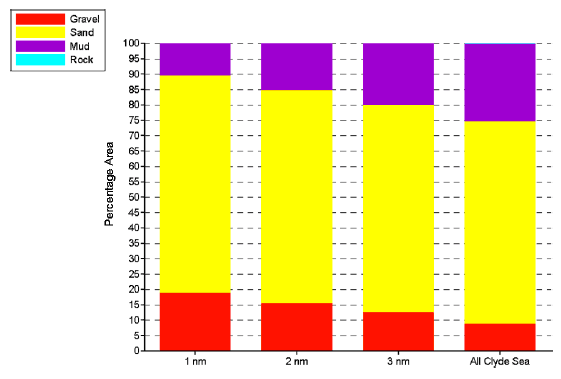
Another summary of this data is presented in table form below,
| Gravel | Sand | Mud | ||||
|---|---|---|---|---|---|---|
| Spatial Domain | Surface Area (km 2) |
% of Clyde Total |
Surface Area (km 2) |
% of Clyde Total |
Surface Area (km 2) |
% of Clyde Total |
| Clyde Sea | 327 | 100 | 2408 | 100 | 929 | 100 |
| Coast to 1 nm | 229 | 70 | 850 | 35 | 127 | 14 |
| Coast to 2 nm | 288 | 88 | 1289 | 54 | 281 | 30 |
| Coast to 3 nm | 299 | 92 | 1584 | 66 | 471 | 51 |
From these figures we can see that 70%, 35% and 14% of all Clyde gravelly, sandy and muddy sediments, respectively, lie within 1nm from the coast. Similar figures are presented for the 2nm and 3nm zones.
9.3.6 Fishing Activity - Raw VMS
In total, using 2010 VMS and FIN data, 66 vessels were found which landed Nephrops in the Clyde, and 24 landed scallops. Figure 9.9 shows the raw VMS data for these vessels. VMS pings from Nephrops vessels which also resulted in landings of cod and haddock are also shown.
Figure 9.9 Raw 2010 VMS pings associated with landings of a) Nephrops, b) scallops, c) cod and d) haddock.
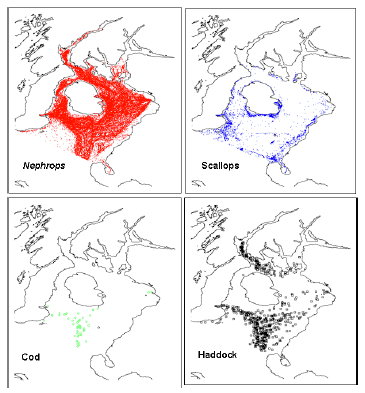
In relation to possible spatial management measures in the Clyde, a summary of fishing activity of the following type may be of relevance,
| Hours | Percentage | |||||||
|---|---|---|---|---|---|---|---|---|
| All Clyde Sea (Hours) |
Coast to 1 nm (Hours) |
Coast to 2 nm (Hours) |
Coast to 3 nm (Hours) |
All Clyde Sea (%) |
Coast to 1 nm (%) |
Coast to 2 nm (%) |
Coast to 3 nm (%) |
|
| ALL | 56,802 | 13,652 | 20,881 | 25,801 | 100 | 24 | 37 | 45 |
| NEP | 53,520 | 13,298 | 19,902 | 24,536 | 100 | 25 | 37 | 46 |
| SCL | 3,223 | 336 | 956 | 1,239 | 100 | 10 | 30 | 38 |
| HAD | 814 | 156 | 210 | 231 | 100 | 19 | 26 | 28 |
| COD | 60 | 17 | 19 | 19 | 100 | 28 | 32 | 32 |
From these figures we can see that of the total 56,802 fishing hours that took place in the Clyde Sea in 2010, 53,520 hours (94%) resulted in a landing of Nephrops, 3,223 (6%) hours landed scallops and just 814 hours and 60 hours landed haddock or cod respectively, most probably as by-catch in the Nephrops fishery. Hence the 66 boats which landed Nephrops from the Clyde in 2010 spent on average 810 hours fishing through the year, and the 24 scallop vessels spent, on average, 134 hours.
In terms of where fishing takes place, of the total 56,801 fishing hours of 2010, 24% occurred within 1 nm from a coastline, 37% within 2 nm and 45% within 3 nm. Therefore 55% of the total fishing activity occurred outwith 3 nm from a coast. This distribution of fishing activity is virtually identical for fishing which landed Nephrops, while it is different for fishing which landed scallops. Here, 10%, 30% and 38% of fishing activity occurred 1 nm, 2 nm and 3 nm from a coast within the Clyde Sea.
9.3.7 Fishing Activity - Interpolated Maps
The interpolated VMS data have been used in order map the distribution of fishing activity in the Clyde in 2010. The resulting distributions are shown in Figures 9.10 and 9.11.
Figure 9.10 The distribution of fishing activity in the Clyde in 2010 based on the number of interpolated pings from vessels believed to be fishing ( i.e. speed of vessel between 1 and 4 knots) in each model grid cell for (left) vessel trips which landed Nephrops and (right) scallops.
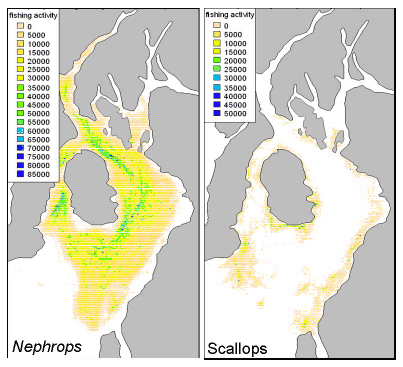
Figure 9.11 The distribution of fishing activity in the Clyde in 2010 based on the number of interpolated pings from vessels believed to be fishing ( i.e. speed of vessel between 1 and 4 knots) in each model grid cell for (left) vessel trips which landed cod and (right) haddock.
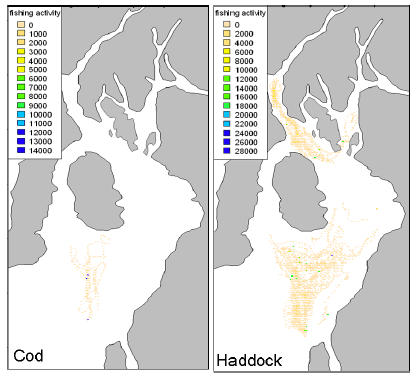
It is clear from the fishing activity maps that it is governed by the habitat types which favour the different species. Boats landing Nephrops principally target the areas where muddy sediments predominate, principally the deep basins of the Clyde, whereas vessels landing scallops target the harder sediments found around the shallower periphery of the Clyde as well as on the Great Plateau. The table below compares the percentage of each sediment type to the percentage of fishing activity in each of the spatial zones.
| Spatial Domain | Gravel | Sand | Scallops | Mud | Nephrops |
|---|---|---|---|---|---|
| % of Clyde Total |
% of Clyde Total |
% of Fishing Activity |
% of Clyde Total |
% of Fishing Activity |
|
| Coast to 1 nm | 70 | 35 | 10 | 14 | 25 |
| Coast to 2 nm | 88 | 54 | 30 | 30 | 37 |
| Coast to 3 nm | 92 | 66 | 38 | 51 | 46 |
For Nephrops the percentages of muddy sediment and fishing activity within the three spatial zones of 1nm, 2nm and 3nm are comparable. However, for scallops the percentage of fishing activity outwith the 3nm zone seems excessively large. This must take place predominantly on the Plateau. Further investigations of this anomaly are underway.
The analysis of VMS data, in conjunction with the other data layers in the CMEM databases, shows how useful this data can be to describe the current fishing practices in the Clyde and to evaluate different management options. However, more can be done.
It is possible to link actual landings to VMS pings if it is assumed each catch is evenly distributed along the vessels fishing path. This would allow summaries as above for spatial measures in terms of weight, and hence value, of landings per species per management area.
Here we have analysed the year 2010 as the most recent full year of data available to this study. However, earlier years and the more recent data can be added to look at changes over time. Similarly seasonal patterns of fishing could be examined.
Simple spatial measures involving set distances from the shore have been examined here. However, CMEM could be used to develop more complex spatial management measures based on, for example, habitat type. Temporal closures could also be examined in addition to spatial ones.
A warning should, however, be sounded. The effects of the displacement of fishing have not been touched upon here. Fishers behaviour faced with closures needs to be considered, and the impact of displaced fishing effort on other areas and habitats evaluated.
The analysis presented here only uses data from those vessels with VMS systems installed, i.e. >15m in length. Data from smaller vessels needs to be collected and analysed using CMEM.
CMEM needs to be further developed. Data sets of habitat type can be improved using finer scale surveys, and additional environmental parameters such as sea bed temperature and sea bed water flow could be added. More years of VMS data need to be included. Seasonal patterns of fishing can be examined. Landings, by species and gear type, from each grid square, as well as value of landings, can be estimated using various methods developed at MSS. A glaring lack currently is information on fishing activity by creel boats, as well as fishing activity by all vessels smaller than 15m. This could be provided by an interview-based data gathering exercise ( e.g. ScotMap, A.McLay pers. comm.).
Contact
There is a problem
Thanks for your feedback